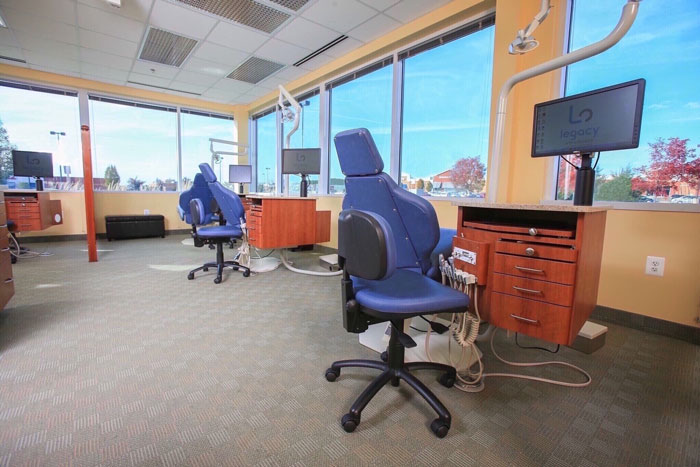Things about Legacy Orthodontics
Things about Legacy Orthodontics
Blog Article
Legacy Orthodontics for Dummies
Table of Contents3 Simple Techniques For Legacy OrthodonticsThe 8-Second Trick For Legacy OrthodonticsNot known Facts About Legacy OrthodonticsLegacy Orthodontics Can Be Fun For EveryoneWhat Does Legacy Orthodontics Mean?
In enhancement, we provide flexible treatment timetables, adaptable repayment choices and an enjoyable, delightful experience.An orthodontist is a dental practitioner trained to detect, avoid, and deal with teeth and jaw abnormalities. Orthodontists function with individuals of all ages, from children to adults.
Malocclusion, or misaligned teeth, can cause dental problems, consisting of tooth decay, periodontal illness, and tough or unpleasant eating. Not every person is birthed with straight teeth. If you have a negative bite or large rooms in between your teeth, you may want to seek advice from a dental professional specializing in orthodontic treatment.
5 Simple Techniques For Legacy Orthodontics
( Picture Credit Scores: DigitalVision/Getty Images) Orthodontists make use of repaired and detachable oral devices, like dental braces, retainers, and bands, to change the placement of teeth in your mouth. Orthodontic therapy is for dental problems, including: Jagged teethBite problems, like an overbite or an underbiteCrowded teeth or teeth that are too much apartJaw misalignmentThe objective of orthodontic treatment is to boost your bite.
A healthy and balanced bite ensures you can consume, chew, and talk effectively. While you may consider orthodontists as primarily for children or teenagers that require dental braces, they can remedy oral problems at any age. Orthodontists participate in college, oral school, and orthodontic school. After graduation, they invest 2 or 3 years in an orthodontic residency program.
All orthodontists are dental professionals, but not all dental professionals are orthodontists. Orthodontic residency programs offer intensive, focused direction for oral specialists. They concentrate on 2 locations: Exactly how to correctly and securely move teeth How to properly guide advancement in the teeth, jaw, and faceOnce an orthodontist has actually finished training, they have the option to end up being board certified.
Some Known Facts About Legacy Orthodontics.
Imbalance, or malocclusion, is one of the most typical factor people see an orthodontist. It is genetic and is the result of size distinctions in between the top and lower jaw or in between the jaw and teeth. Malocclusion brings about tooth congestion, a misshapen jaw, or uneven bite patterns. Malocclusion is normally treated with: Your orthodontist attaches steel, ceramic, or plastic square bonds to your teeth.
If you have only small malocclusion, you might have the ability to make use of clear dental braces, called aligners, as opposed to conventional braces (https://www.wattpad.com/user/legacyortho1). Some individuals need a headwear to help move teeth right into line with pressure from outside the mouth. After braces or aligners, you'll need to use a retainer. A retainer is a custom-made tool that like it maintains your teeth in area.
They're most often used on youngsters. They can develop added room in the mouth without having to pull teeth. If you have a major underbite or overbite, you may need orthognathic surgical procedure (likewise called orthodontic surgical procedure) to extend or shorten your jaw. Orthodontists use cords, medical screws, or plates to support your jaw bone.
You may need to see an orthodontist if you have: Crowding or otherwise enough area for all of your teethOverbite, when your top teeth come your base teethUnderbite, when your base teeth are as well far forwardSpacing or concerns with gapsCrossbite, which is when your top teeth fit behind your base teeth when your mouth is closedOpen bite or an upright space between your front base and top teethMisplaced midline, when the center of your bottom and upper teeth do not align Dealing with a dental malocclusion can: Make attacking, eating, and speaking easierImprove the proportion of our face and your overall appearanceEase pain from temporomandibular joint problemsDifferent your teeth and make them simpler to clean, assisting avoid dental caries or cavities It's often a dental practitioner who first notices misaligned teeth throughout a routine test.
Legacy Orthodontics for Beginners

During your initial orthodontic examination, you'll likely have: A dental examPhotos taken of your face and smileDental X-raysPanoramic (360 level) X-rays of your face and headImpressions to create molds of your teethThese examinations will assist your orthodontist recognize how to continue with your treatment. invisalign. An orthodontist is a dentist that's had training to treat your teeth and jaw
An orthodontist is concentrated on your bite, so something like a broken tooth would be handled by a dental practitioner. Orthodontists are concentrated on your bite, or the means your teeth fit together, and the straightness of your teeth.
Ever asked yourself exactly how celebs always appear to have perfectly lined up teeth? The answer frequently exists in the knowledgeable hands of an orthodontist. What precisely does an orthodontist do? Orthodontists are oral professionals that focus on remedying irregularities in the teeth and jaws. Their experience exceeds simply producing a beautiful smile; it reaches improving your overall dental wellness and feature.
Indicators on Legacy Orthodontics You Need To Know

, orthodontists have a varied toolkit at their disposal. These reliable braces make use of a system of braces bonded to the teeth and attached by cords.
Clear aligners, like Invisalign, are a popular choice for clients looking for a much more discreet treatment choice. These removable trays are customized to progressively change the teeth's position. Headwear might be used together with dental braces or aligners to apply extra targeted pressures, specifically for remedying jaw discrepancies. In instances of slim jaws, palatal expanders can be utilized to create room for proper tooth placement.
Report this page